Owens Valley (again)
Thing is about the Owen’s Valley… if we ever get everything “seen” (the mind boggles), we’ll have forgotten half of it by then. It’s a place that deserves – and rewards – multiple visits.
This time, we were solidly in “base camp” mode. We find a place that’s reasonably remote, but still with some cell service, and plonk Howie (the motorhome) down for a while. Then we do day-trips in Jayk the Jeep. Howie’s fridge, water tank, compost toilet and solar/lithium infrastructure allows us to stay out for 10 days or longer before we need to re-provision.
DOWN SOUTH
We stayed first at a previously newly-discovered place below Olancha, Fossil Falls. This time, we elected to bypass the BLM campground (which had opened since our last visit). It’s a nice enough campground, and cheap ($5), but we wanted just a bit more space than even the 200’ distance between sites. We trekked out onto the dry playa, and found we still had okay cell service even a couple of miles away from 395.
Our first “camp” (really just parked) turned out to be infernally dusty, and we moved to a more rocky-soil area a half-mile further in. Lots easier to keep Howie from becoming a dust bowl.
See all that white alkali layer? Well, it likes to follow you around… everywhere.
Ah, same white stuff but with lots of volcanic ‘gravel’ on top. MUCH better.
FOSSIL FALLS HIKE
You just can’t camp at Fossil Falls and not go see it… probably not legal. ![]() But even having been there before, we still enjoyed the weird lava-rock sculptures again. This time, we went in “the front way”, via the published trail. Except for a couple of hilly/rocky stretches, it was easier than the longer back road off the playa.
But even having been there before, we still enjoyed the weird lava-rock sculptures again. This time, we went in “the front way”, via the published trail. Except for a couple of hilly/rocky stretches, it was easier than the longer back road off the playa.
It’s always a real treat to inspect and admire the work of ancient waters in sculpting the lava stonework.
LITTLE LAKE OVERLOOK
Down a rocky, rough powerline maintenance road (off the south end of the playa), we got a lofty view of the totally-private Little Lake and surrounding land. Just west, 395 scoots by, a scratch in the desert.
A boat dock and boat house, plus the ranch house or clubhouse or whatever, seem still to be in good shape.
Little Lake was formed by a dam put up by (you guessed it) LADWP. The Lake and the land have quite a storied history, as a travel stop, guest/fishing ranch, and small town of 50+ residents. The railroad that kept the community alive was abandoned (even the rails were removed), and the town withered away. Buildings were burned and demolished and the land somewhat restored. As of today, it’s ALL privately held, and inaccessible (legally). We tried various roads that looked like (on the maps) they went around the property; no such luck, we were always stymied by gates large and small.
There’s actually a little bitty frontage road off of 395 that goes straight to the property, but it is of course gated. That’s about all I know.
Across 395, on the western flank of the valley, is an old railroad bed that would have been roaring in the town’s heyday. It’s mostly an easy Jeep road — until you get to one of the 20-foot-deep washouts gouged by seasonal runoffs. One of them is between the dark wood barricades. It would be WAY too easy to drive into that bad boy; I’m glad the barriers are there. Also, enterprising off-roaders have worn rugged paths around the gulches. We continued past a barricade or two, and then went on to other explorations.
THE WATER PIPELINES
The brooding presence of the Los Angeles Department of Water and Power — LADWP for short — looms over every corner of the Owens Valley. Having long ago bought up 90% of the water rights, and piped it all to the thirsty LA basin, LADWP has forever changed the character of the valley. But rather than letting it all get us down, we generally decide to “squeeze the lemon and make lemonade”, as the saying goes. Let’s explore it; it’s an astounding piece of engineering. Is it accessible? Sometimes. In some areas, LADWP does restrict access, but in most places, we could wander at will — and we did.
The pipelines and aqueducts are everywhere, not one or two or three, but many. They stretch, bend, and wander across hundreds of miles of desert, sometimes easily spotted, sometimes almost completely hidden from view.
There are these ancient-looking, black-as-coal versions…
… and seemingly pristine beige-white runs.
The big 10-foot diameter pipes will emerge from a buried canal, cross a gulch or canyon, and then re-enter another canal. Nowhere did we see the water itself (except at sources). The canals are well-covered, with access points at uneven intervals. Considering that there’s NO pumping going on, it’s a pretty amazing feat of engineering.
There are no warnings or precautionary signage about driving a two-ton Jeep (or any vehicle) on top of the aqueduct covers. But we didn’t have to, didn’t want to, and just plain didn’t. It felt kinda creepy.
We followed this stretch of road for miles, along pipes and canals, twisting and turning. After 10 miles or so, we were just 3/4 mile from getting back on 395 (a really cool “loop”), when the whole roadway was blocked, gated, stopped, with steep canyon walls and no bypass or workaround. Just a bunch of insurmountable obstacles up against the foothill terrain. What did we do? Duh. We went 10 miles back. (Note to self: ALWAYS carry lots of gas.)
ALIEN BEACONS
While we were out exploring around Little Lake, we saw the strangest sight: a long string of bright blinking white lights, far off in the desert west of 395, maybe 5-10 miles away from our position. “Aviation” was my first thought, but the lights appeared to be low to the ground. Furthermore, the blinking rate was erratic and intermittent, not at all like standard warning/position lights.
Maybe it was “keep out” signs on a fence line, wobbling in the wind. Or maybe a weird weather phenomenon? Was it a secret landing strip for aliens? We truly had no clue.
It was too distant and faint to photograph, but when we drove down the terrain toward it, the entire display simply disappeared. So we were flummoxed, and just had to go investigate. Long story short, we wandered up and down the west side of the valley for at least an hour, without ever seeing the flashing lights again… and then, almost by pure luck (and a bit of dead reckoning), we found them!!! Turned out, my first guess was the closest, but no cigar.
Can you see them?? They flop back and forth in the wind…
When they flop away from the light, they’re dark; when they flop toward the light, they’re bright white.
When you get off-angle, you don’t see them at all. What are they? They are NOT warning signs. They are nodal disruptors, changing the natural oscillation frequency of wires to prevent self-destruction from resonance during high winds.
You personally might not care at all about this. I totally understand. As a life-long OCD engineer, I’m quite accustomed to caring deeply about things that are of little/no consequence to others. ![]()
FARTHER NORTH
After Fossil Falls, we passed by some familiar haunts near Lone Pine and Independence, and decided to explore around Bishop a little bit. [Side Note: Did you know that US-6 runs continuously from southern California all the way to Massachusetts?]
We were eager to try out a lonesome road up north out of Bishop. The Casa Diablo Road turned out to be a really long, and easily navigable, road through what is called the Volcanic Tablelands area.
It’s a huge place, and although it has many camp sites scattered along its span, and it’s fairly close (5-10 miles) to Bishop, it looks and feels extremely remote and lonely — just our cup of tea. Three bars of 4G and nobody around.
WINDY!!! – boy howdy, we had some days. The winds were variable, but sometimes they ‘varied’ really strong and gusty. And one day would be howling out of the north, another just as strong from the south. At one point, it became so difficult to open/close Howie’s side door, that I actually had to move and re-position our parking angle. Fortunately, a combination of very light traffic and lucky wind directions kept the prodigious dust blowing away from camp. (Fact is, we’d only see maybe 2-3 cars in a day that passed by.)
DESERT LIFE
Most of the “critters” of the desert are active only at night, but occasionally we got a glimpse during the daytime. And of course, the flora is in view 24 hours (and flowers’ petals like to open in daylight). This being April, and having had some recent spotty rainfall, some wildflowers could be found…
Sometimes, you have to look VERY close to see them…
CROWLEY COLUMNS
One day, we decided to go visit the not-well-known Crowley Columns, some geological structures at the east side of the lake of the same name.
Normally, one would visit the columns by a modest dirt-road jaunt off of 395; but we decided to explore out Casa Diablo Road instead. We did lots of research on paper maps, Google Maps, and satellite views. It looked like we could get there…. maybe. If not, oh well, we’d see new places, turn back, and then go for the Columns another day.
Heading out across the Volcanic Tablelands to the northwest, we trekked along easy-but-rough roads, climbing gradually until we left the brushy desert. We passed through a band of pinyon/pine forest, and leveled off in the evergreen forest of the Inyo around 8000′, with the high Sierras in the far background. It was a gorgeous, lonely, ever-changing journey through different geologies and ecologies.
As we dropped off of the high Tablelands, back down towards the Owens River and 395, we had to do some satellite-view navigating, including some heavily-traveled, really steep sections. Near the Columns, we encountered several folks who had elected to walk the last two miles to get to them; it was obvious to all that city cars would NOT be able to negotiate the road. Jayk had no issue, but Jayk has front/rear Trutraks, 35″ tires, and 15″ of ground clearance.
The parking area that we chose was at the top of a hill, 200 feet above the water. There were other parking areas, but not within decent walking distance of the main Column area. (My Lyme was not treating me well that day, and the hot sunny climb was a bit of a worry.)
Even going DOWN was a workout (for me), but the geology was so worth it. These weird structures were formed by mineral-laden waters percolating DOWN through a mixed porous sub strata. They caused hardening of some of the material in the strata. Later, the man-made Lake (once again, LA County messing with Owens Valley water) soaked into the all-solid strata, and dissolved the un-hardened material.
The result is almost Romanesque, and quite striking both visually and intellectually.
[As it turned out, I was more physically ready than I thought, and the climb back up the hill was pretty much a non-event. That felt good; I’ve been too-limited by this disease for way too long. And as of this writing, I’m doing even better.]
We had learned previously that we were roaming around during the “opening weekend” of trout season. Nowhere was this more apparent than further along the Crowley Lake shoreline… a dense little family/friends camp with a “kitchen” that would put some restaurants to shame. I just hope the winds stayed tame for them…
BISHOP AREA, OUT and ABOUT
With our usual “map shopping”, several features in the area asked for exploration. So we complied, and explored.
Silver Canyon was one of the places we had thought about camping. It wanders higher and higher up toward the White Mountains. Although it did have its appeal, it wasn’t as lonely and spacious as Casa Diablo Road; we were happy with our choice.
This guy seemed to have been in residence for quite a while. Interesting combination of ancient rusty bus, new aluminum wheels, and sophisticated antennae.
Along the western fork of the Owens River: The ubiquitous LADWP is everywhere… here, 300 miles north of Los Angeles, the land and water are regulated by the absentee water-rights landlord. This is a faded warning near the Pleasant Valley Dam.
Southwest of Bishop (18 miles out 168), the alpine Lake Sabrina was a shadow of its prime, and severely drought-shrunken… but still pretty.
On the way back towards Bishop, we had a grand view from 168 of the Volcanic Tablelands plateau, where Howie was waiting for our return.
SENDOFF SUNSET
We’ve had the joy of a LOT of gorgeous sunsets in our travels, some in the US, some in far-off lands. But this one may have topped them all. Most impressive was that it literally surrounded us, with orange/golden wonders in every direction. This was the last evening before going home — what a nice Adios. Life is good.
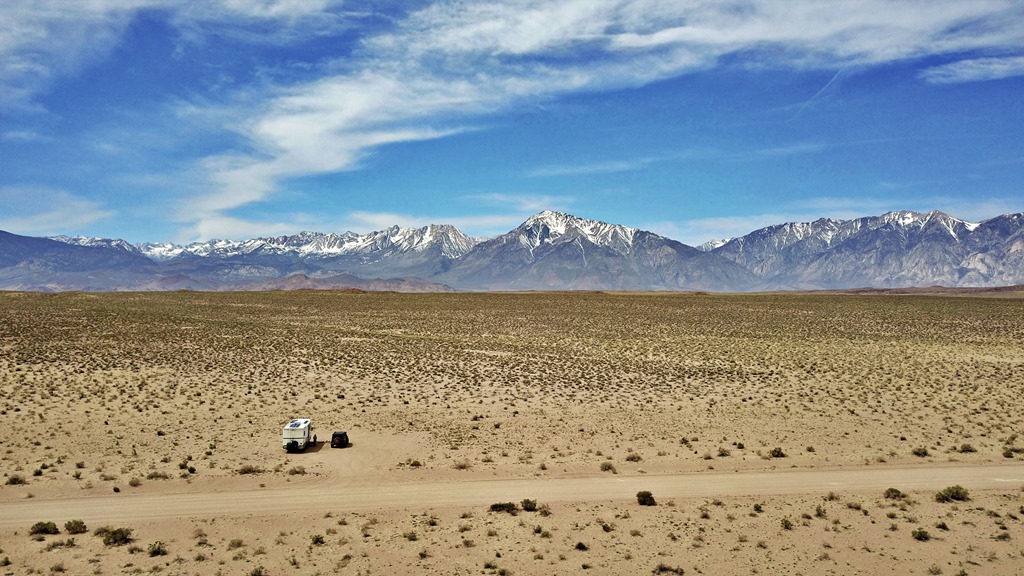
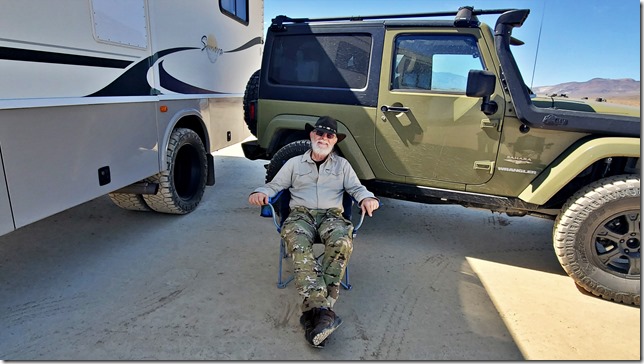
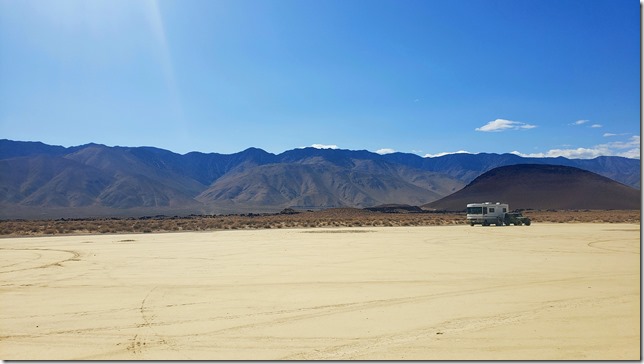
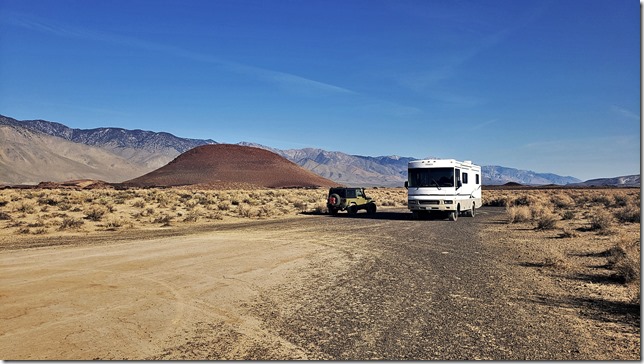
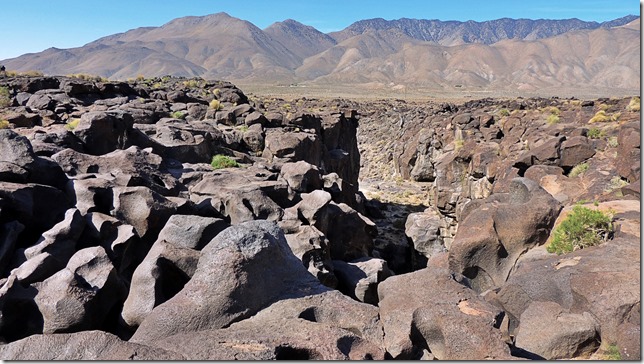
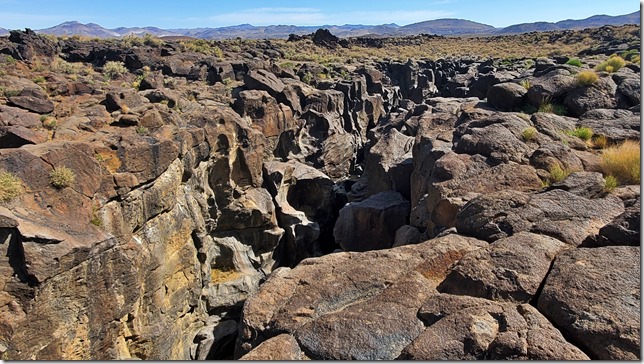
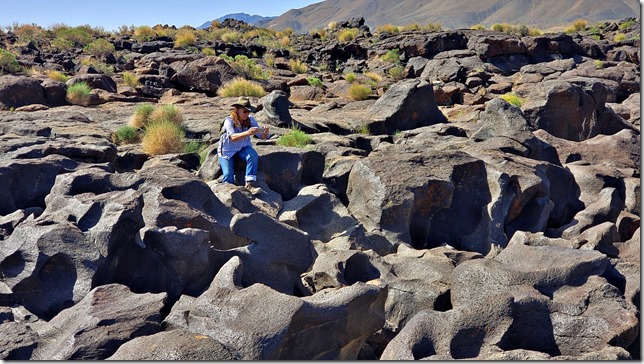
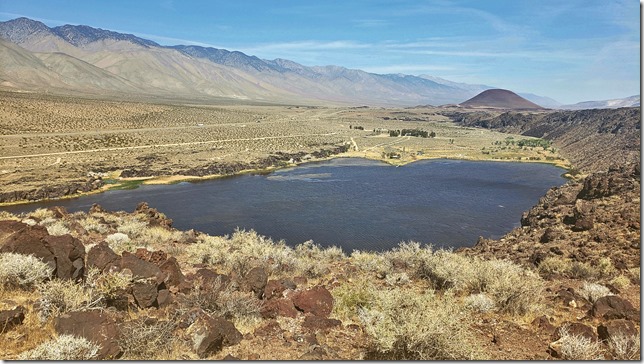
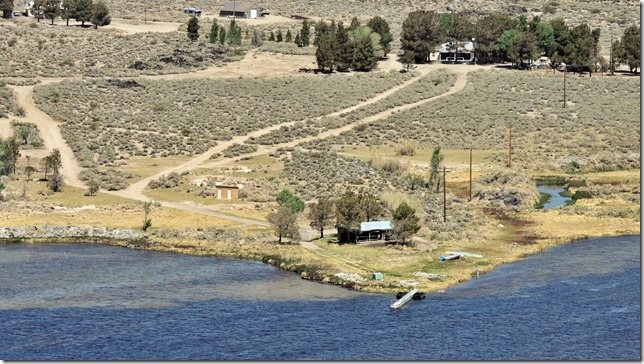
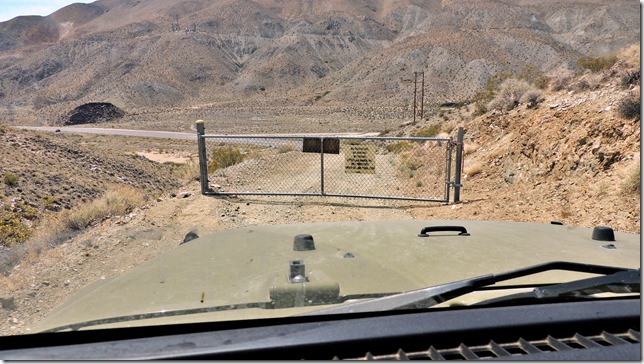
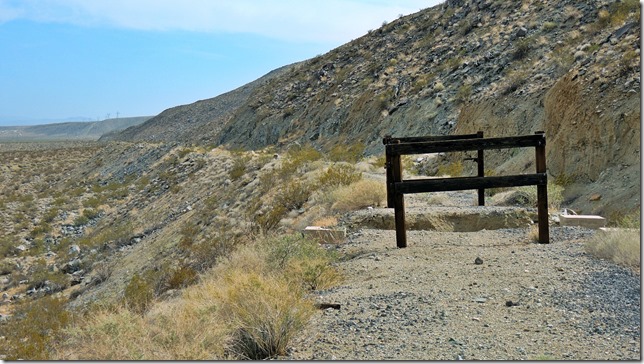
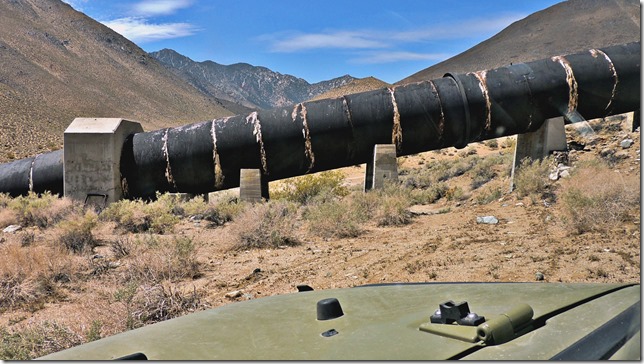
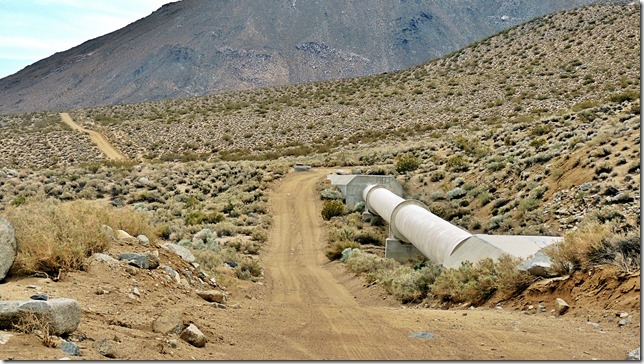
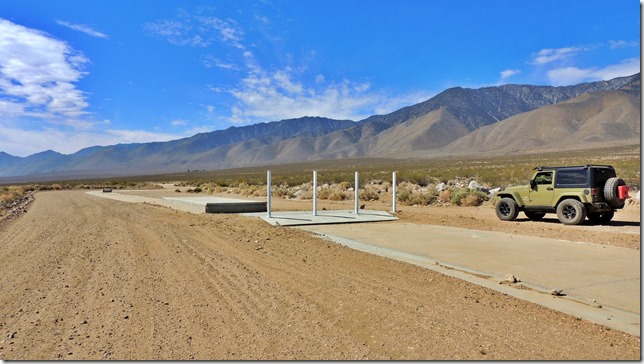
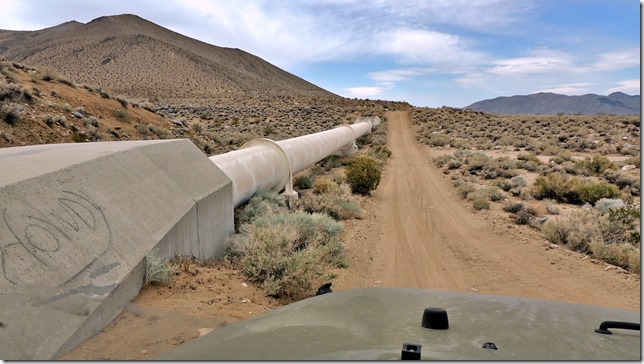
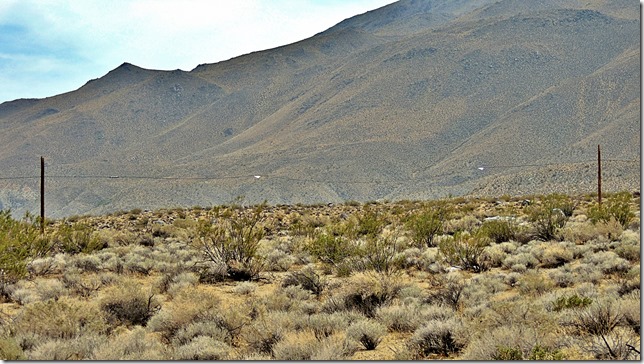
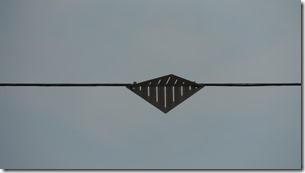
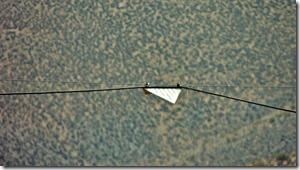
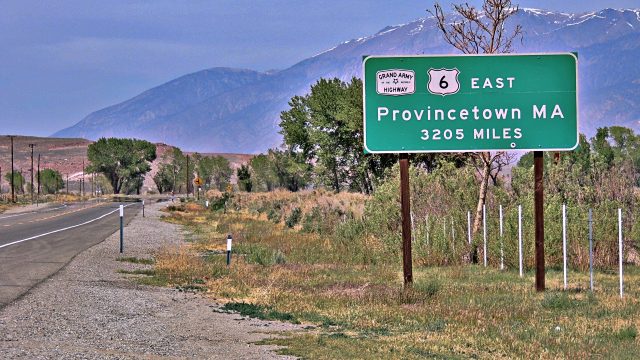
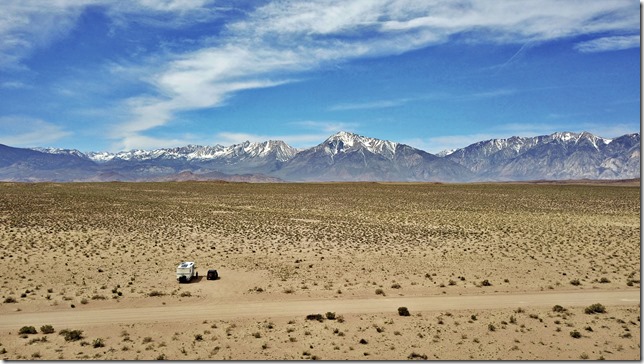
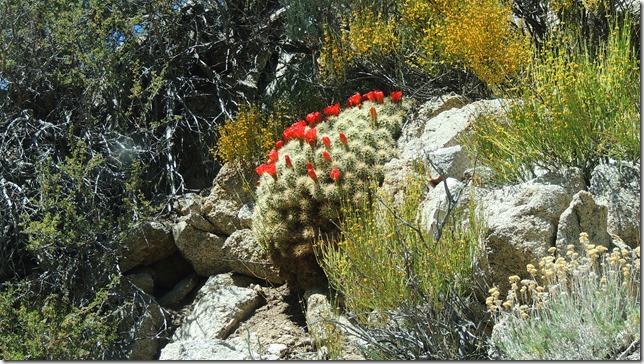
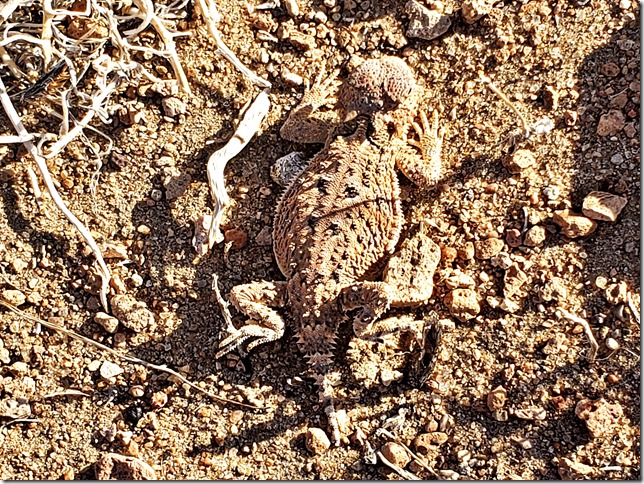
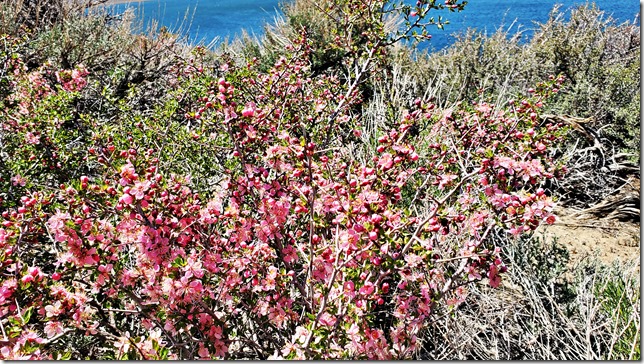
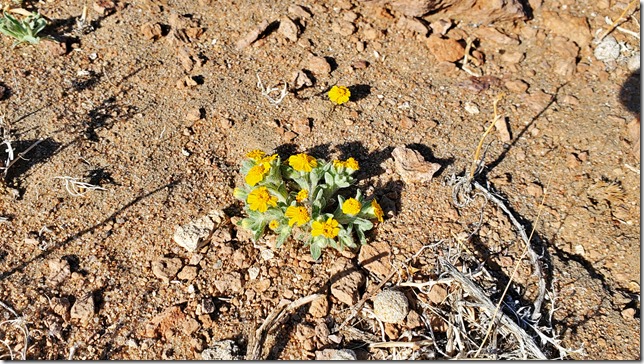
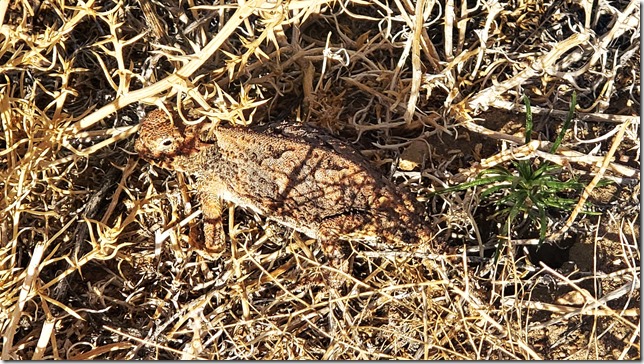
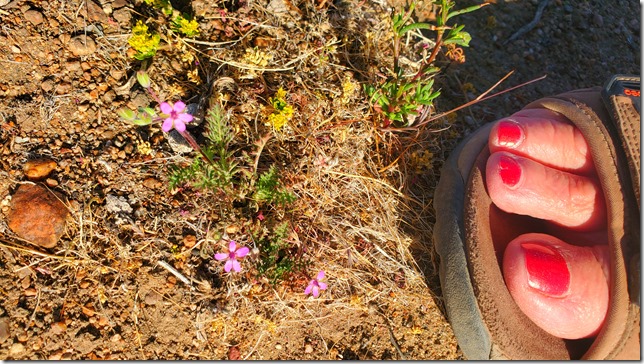
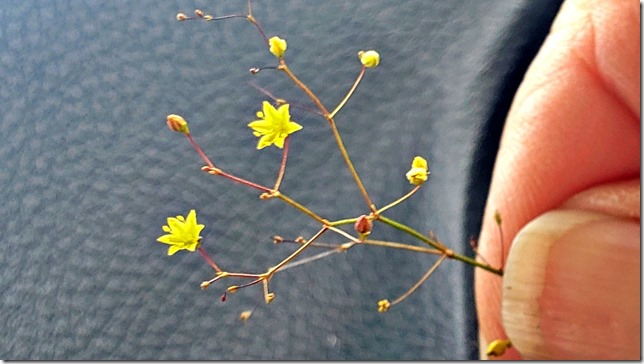
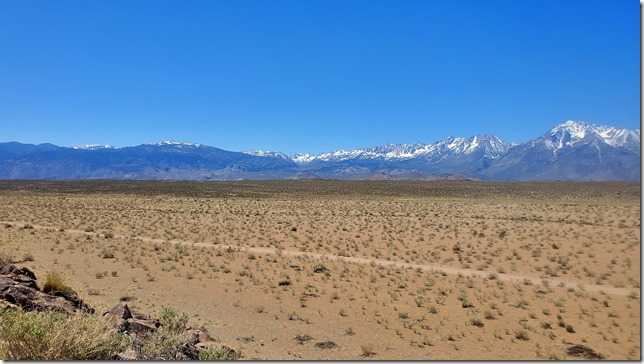
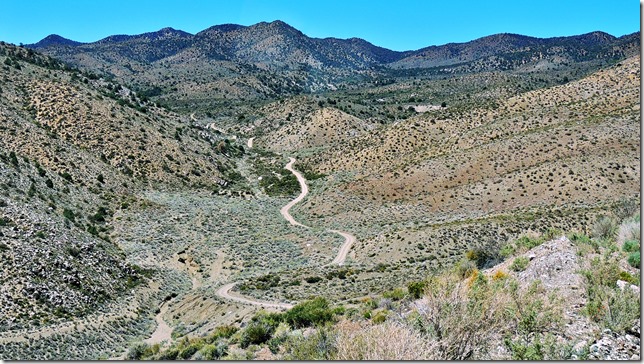
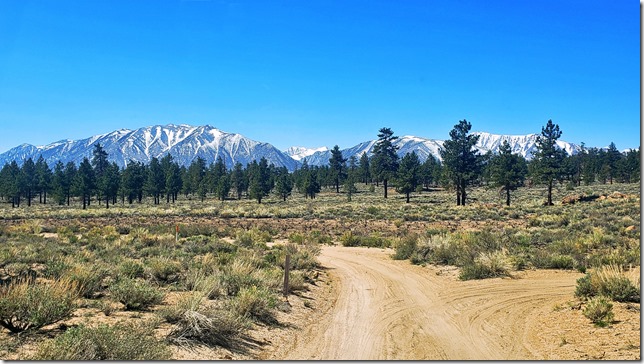
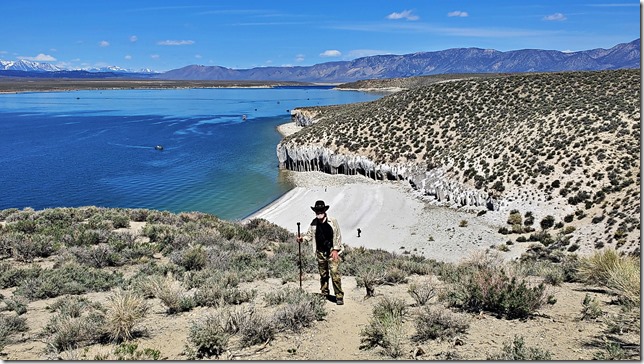
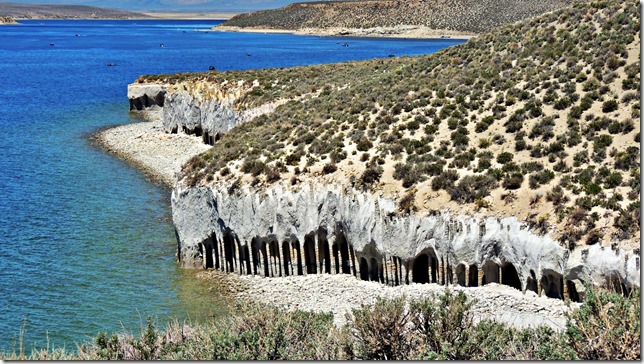
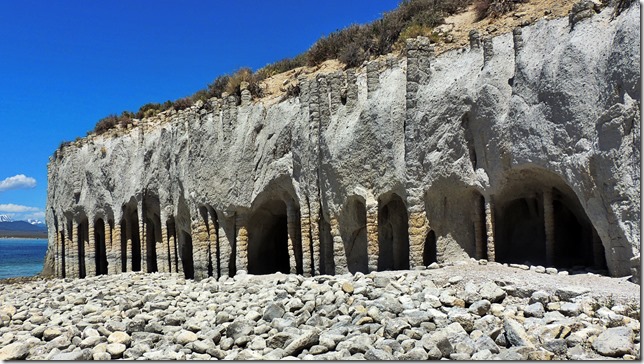
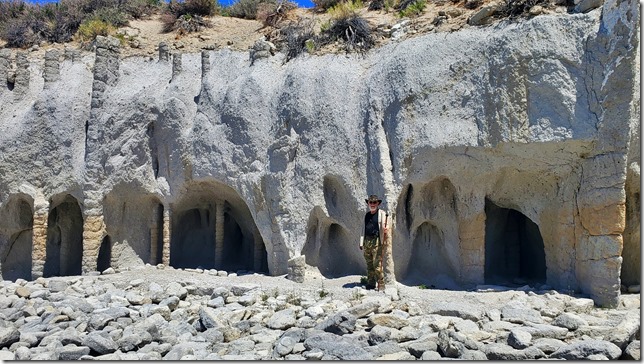
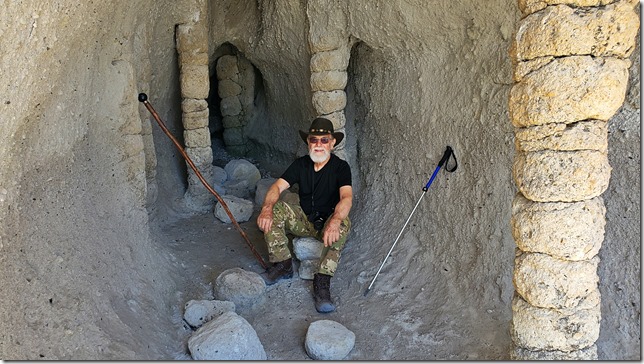
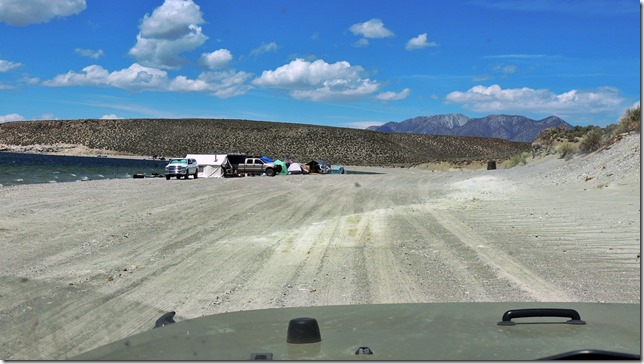
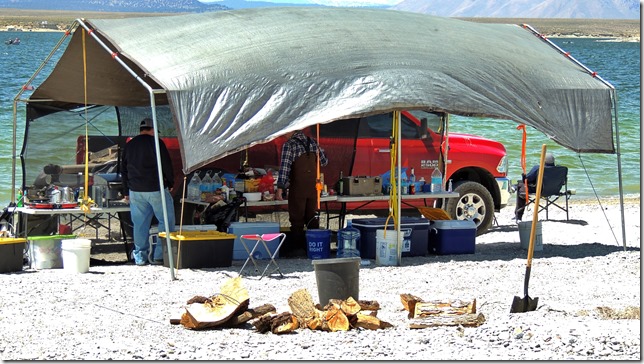
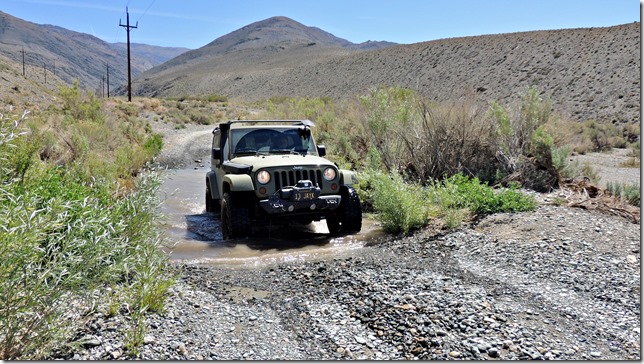
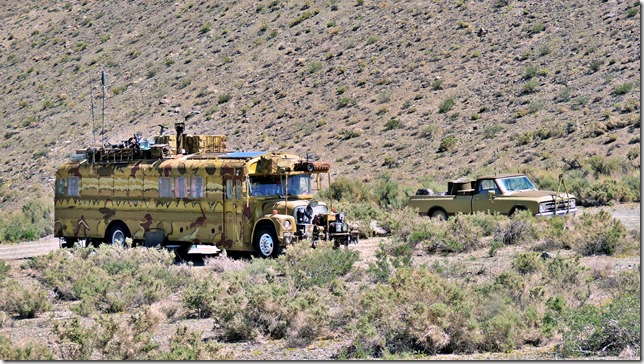
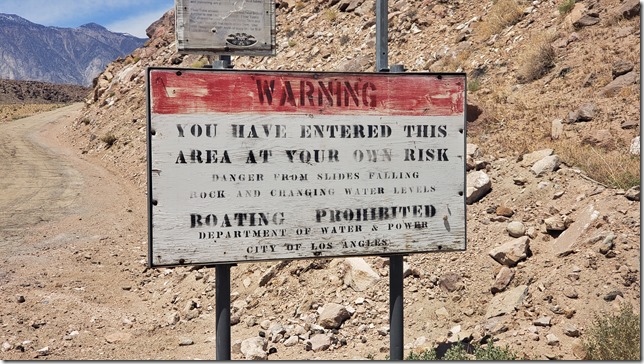
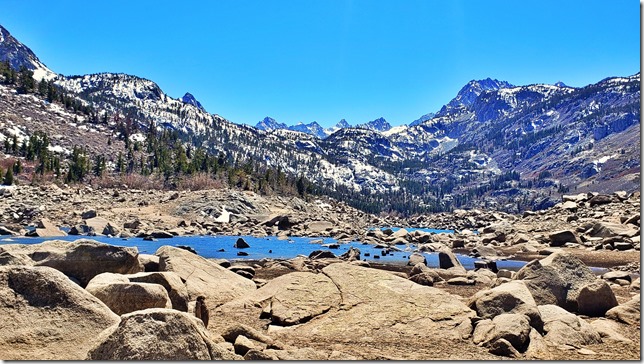

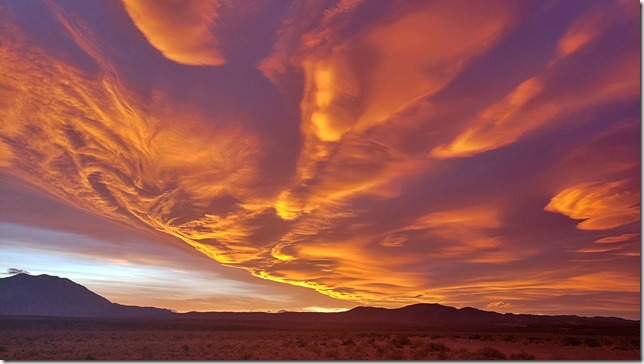
Thank you for the wonderful vicarious trip, Greg. Great explanations (even the technical ones – very interesting!) and amazing pictures. I’m glad to hear you’re feeling better. Take care.
So cool!! Your posts are always great, thanks Greg
Love the Owens Valley…we just passed through last week on the way home to San Diego from Maupin in eastern Oregon. Stopped one night at the Bootleg USFS campground just off 395, north of Bridgeport. The huge campground was empty! Not even a host was on-site. Where is everybody??
Lake Sabrina is nice when it’s full, but you know those folks in LA need their water!
Thanks again for another great post.